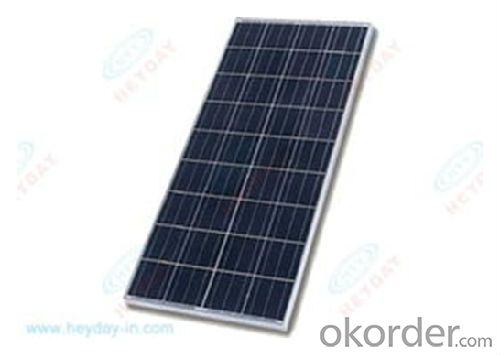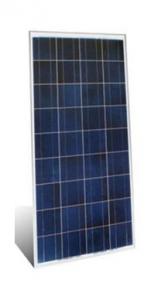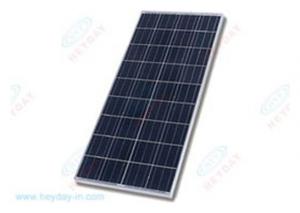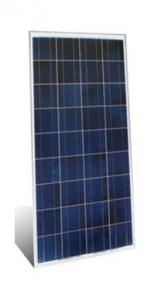Solar Modules Poly-crystalline 130W 156*156 Module
OKorder Service Pledge
OKorder Financial Service
You Might Also Like
Solar Module Descriptions:
Solar Power Modules (known as Photovoltaics - PV) can generate electricity for your home or business, either as part of a stand-alone solar power system, or for buildings already connected to the local electricity network.
Customers benefit from our progressive system innovations. Around the world, we meet our customers' desire for the greatest possible reliability, long-term performance and aesthetic integration. No matter which kind of roof – we always have the right solution.


Electrical Characteristics
Max-power (W) | 130 |
Max-Power Voltage (V) | 17.9 |
Max-Power Current (A) | 7.30 |
Open-Circuit Voltage (V) | 21.74 |
Short-Circuit Current (A) | 8.05 |
Mechanical Characteristics
Cable type, Diameter and Length | 4mm2, TUV certified, 1000mm |
Type of Connector | Compatible with MC4 plug |
Arrangement of cells | 4*9 |
Cell Size | 156*156 |
Dimension | 1482*676*40 |
Weight | 12Kg |
Glass, Type and Thickness | High Transmission, Low Iron, Tempered Glass 3.2mm |
Features
Guaranteed positive tolerance 0/+5w ensures power output reliability
Strong aluminum frames module can bear snow loads up to 5400Pa and wind loads up to 2400Pa.
Excellent performance under low light environments (mornings evenings and cloudy days)
12 years for product defects in materials and workmanship and 25 years for 80% of warranted minimum power.
Certifications and standards: IEC 61215.
Manufactured according to International Quality and Environment Management System (ISO9001, ISO14100).
FAQ
Q: Do you have any MOQ limit?
Our MOQ is 200 pieces.
Q: How long is the warranty period for the solar modules?
15 years 90% of its nominal power rating.
25 years 80% of its nominal power rating
- Q:What is the purpose of the load output on a solar controller?
- The purpose of the load output on a solar controller is to provide power to a connected load, such as lights or small appliances, directly from the solar panel system's battery. This feature allows for the utilization of solar energy during periods when the sun is not shining or when the solar panel system is not generating enough power to meet the load requirements. By connecting the load directly to the battery, the solar controller ensures that the load receives a consistent and stable power supply, maximizing the efficiency and reliability of the solar system. Additionally, the load output often includes various protection features, such as overcurrent and overvoltage protection, to safeguard the connected load from any potential damage. Overall, the load output on a solar controller serves to enhance the functionality and versatility of a solar panel system by enabling the utilization of solar energy even when the conditions are not optimal for power generation.
- Q:What is the meaning of the 30A solar controller?
- The maximum current is 30A
- Q:Can a solar controller be used with a mobile solar setup?
- Certainly! A mobile solar setup can indeed utilize a solar controller. When it comes to solar power systems, including mobile setups, a solar controller is an indispensable component. Its primary role is to regulate the electricity flow from the solar panels to the battery bank, ensuring optimal charging while safeguarding against overcharging or battery damage. The significance of a solar controller is further amplified in mobile solar setups, such as those found in RVs, boats, or portable power stations. It plays a vital role in maintaining a stable power supply, shielding the batteries from overcharging or discharging, and maximizing the solar panels' efficiency. A solar controller effectively monitors the battery voltage and adjusts the charging parameters accordingly. It commonly includes features like battery temperature compensation, battery equalization, low-voltage disconnect, and various charging modes (such as bulk, absorption, and float) to optimize charging and extend battery life. Furthermore, certain advanced solar controllers offer additional functionalities like remote monitoring, data logging, and compatibility with mobile apps. These features empower users to conveniently monitor and control their solar setups. Hence, it is highly recommended to employ a solar controller with a mobile solar setup to ensure safe and efficient operation, protect the batteries, and make the most of solar energy utilization.
- Q:How does a solar controller handle battery float charging?
- A solar controller handles battery float charging by continuously monitoring the battery voltage and adjusting the charging current accordingly. Once the battery reaches its maximum charge level, the solar controller automatically reduces the charging current to a lower level to maintain the battery's charge without overcharging it. This float charging mode helps prevent battery damage and prolong its lifespan.
- Q:How does a solar controller prevent damage to the solar panels during low voltage conditions?
- A solar controller, also known as a charge controller, is an essential component in a solar power system that helps prevent damage to the solar panels during low voltage conditions. During low voltage conditions, such as when the solar panels are not receiving sufficient sunlight or when the battery is fully charged, the voltage output from the solar panels can drop significantly. This low voltage condition can potentially damage the solar panels and reduce their overall lifespan. To prevent such damage, a solar controller regulates the voltage and current flowing into the battery or the connected load. When the voltage from the solar panels drops below a certain threshold, the solar controller intervenes and adjusts the charging parameters accordingly. One of the primary functions of a solar controller is to ensure that the battery is not overcharged, as this can lead to damage or reduced performance. It monitors the battery's state of charge and adjusts the charging current to maintain a safe voltage level. During low voltage conditions, the solar controller may reduce or interrupt the charging current to prevent overcharging and potential damage to the solar panels. Additionally, a solar controller also protects the solar panels from reverse current flow. At night or during periods of low sunlight, the power generated by the solar panels can flow back into the panels, causing damage. The solar controller prevents this reverse current flow by blocking the current from flowing in the wrong direction, thus protecting the panels from damage. Overall, a solar controller plays a crucial role in safeguarding the solar panels during low voltage conditions. By regulating the voltage and current, monitoring the battery's state of charge, and preventing reverse current flow, the solar controller ensures optimal performance and longevity of the solar panels in varying environmental conditions.
- Q:Can a solar controller be used with a generator or grid power as a backup?
- Yes, a solar controller can be used with a generator or grid power as a backup. A solar controller regulates the charging and discharging of batteries in a solar power system, and it can seamlessly integrate with a generator or grid power source when additional or backup power is needed.
- Q:Can a solar controller be used with a solar-powered parking meter?
- Yes, a solar controller can be used with a solar-powered parking meter. A solar controller is responsible for regulating the flow of electricity from the solar panels to the battery or load, ensuring efficient charging and preventing overcharging or damage. In the case of a solar-powered parking meter, a solar controller would help manage the energy generated by the solar panels and ensure it is properly stored and utilized to power the meter's operations.
- Q:How does a solar controller handle shading on solar panels?
- A solar controller handles shading on solar panels by employing a technology called Maximum Power Point Tracking (MPPT). MPPT allows the controller to continuously monitor the output of the solar panel and adjust the voltage and current to achieve optimal power generation. When shading occurs on a solar panel, the controller detects the decrease in power output and dynamically adjusts the operating conditions to minimize the impact of shading. This ensures that the solar panel operates at its maximum efficiency, even under partial shading conditions.
- Q:Can a solar controller be used with a solar inverter?
- Yes, a solar controller can be used with a solar inverter. The solar controller regulates the charging of the batteries connected to the solar system, while the solar inverter converts the DC power from the batteries or solar panels into AC power to be used by household appliances. Both devices work together to optimize the efficiency and functionality of a solar power system.
- Q:Is it possible to connect multiple solar controllers together?
- It is indeed possible to connect multiple solar controllers together, which enables them to collectively charge a shared battery bank. This can be accomplished by linking the outputs of each solar controller in parallel. However, it is crucial to verify that the combined capacity of the solar controllers does not surpass the maximum charging capacity of the battery bank. Moreover, it is essential to adhere to proper wiring and cable sizing practices to reduce voltage drop and guarantee optimal functionality. Consulting the manufacturer's guidelines and specifications is also recommended to ensure compatibility and prevent potential problems.
1. Manufacturer Overview |
|
|---|---|
| Location | |
| Year Established | |
| Annual Output Value | |
| Main Markets | |
| Company Certifications | |
2. Manufacturer Certificates |
|
|---|---|
| a) Certification Name | |
| Range | |
| Reference | |
| Validity Period | |
3. Manufacturer Capability |
|
|---|---|
| a)Trade Capacity | |
| Nearest Port | |
| Export Percentage | |
| No.of Employees in Trade Department | |
| Language Spoken: | |
| b)Factory Information | |
| Factory Size: | |
| No. of Production Lines | |
| Contract Manufacturing | |
| Product Price Range | |
Send your message to us
Solar Modules Poly-crystalline 130W 156*156 Module
OKorder Service Pledge
OKorder Financial Service
Similar products
New products
Hot products
Related keywords






























